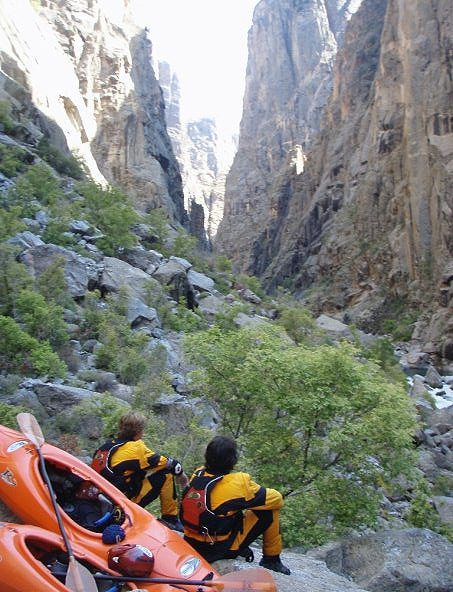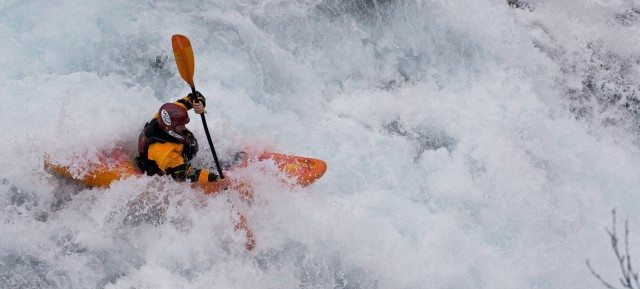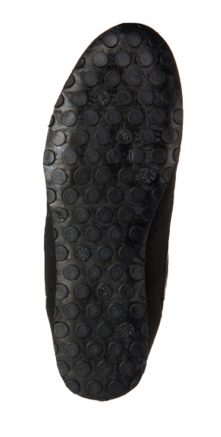
Shoe: Five Ten Water Tennie
Size Reviewed: 9
Style: Creeking Shoe
Upper: Neoprene Mesh
Lower: Stealth Rubber
My street shoe size: 9.5
My foot: wide, low arch, pronounced heel
Days Tested: ~150
Test Locations: Norway, Colorado, Washington State, Grand Canyon, and more
MSRP: $120
I vividly remember the first time I realized how paddling footwear can make or break a trip. Although I had been paddling for almost 7 years, I’d never had to do a truly menacing portage until my first trip to the Black Canyon of the Gunnison in Colorado.
I was halfway through a mile-long death march through scree slopes, boulder fields, and forests of 5-foot-tall poison ivy trees. I’d dropped my heavily loaded boat multiple times as I slipped and fell in my inadequate playboating booties. I said to my brother, Eli, “I’m never doing this ever again.”
Well, I was wrong. I’ve returned many times to the Black, and have become hooked on expedition boating. But now I know to bring good footwear.

Since that experience, I’ve tested many different footwear options for expeditions that sometimes involve just as much walking as paddling.
I look for a shoe with good support, great traction, that also drains water quickly.
The 5.10 Water Tennie is meant to be a do-it-all amphibious tool for paddlers, fishermen, and canyoneers. It has quickly become one of the most popular shoes for boaters who consistently trek through rough terrain on long hikes.
However, I think the 5.10 Water Tennie is lacking in a few ways (more on this below). The shoe strikes a good balance between comfort in the boat and performance on land, but I would like it to have a slightly stiffer sole for long hikes.
Design / Fit
The Water Tennie is constructed with an upper that’s made of synthetic mesh and neoprene. The fabric lets it drain quickly so I’m not constantly sloshing around with water in my shoe.
The mesh and neoprene will be a nice change if you are used to wearing an old pair of tennies or other shoes not specifically designed for land and water.
I love that the Water Tennie has a higher top than many other comparable shoes, including the popular Astral Brewer. The top rises above my ankle, which helps keep out gravel, scree, and other debris. I appreciated this design for two reasons:
1) I love not having rocks in my shoes (weird, I know).
2) Since it keeps little rocks and dirt out, the high top lengthens the lifespan on my drysuit booties when I wear them under the shoe.
The Water Tennie has two pull tabs, one on the heel and one on the tongue, to help the paddler pull on the shoe. This is good, since it’s hard to pull the shoe over my heel even with the tabs.
Perhaps I just have a bony, pronounced heel, but this shoe is tough to pull on even with the top few levels of lacing completely loosened. This is especially true when the shoe hasn’t been used in a while, since the neoprene and mesh shrink when dry.

Sizing
I typically wear a size 9.5 or 10 shoe, but I wear a size 9 Water Tennie, and I’d suggest going a half size down from your usual size.
With a size 9, I can fit the Water Tennie into my Dagger Nomad 8.5, Habitat 74, and Jackson Kayak Rock Star M. The fact I can fit it into the Rock Star means I don’t have to get a separate pair of shoes for creeking and playboating—a big bonus in my book. I could never do this with beefier creek shoes like the 5.10 Canyoneer and SAR, which are basically full-on boots.
It’s important to consider how often you wear a drysuit when you’re buying a paddling shoe and deciding on a size. Since I often paddle in cold conditions and will wear a drysuit with thick wool socks and Gore-Tex booties, I decided to leave a bit of extra space in my shoes.
This means I have a little “slop” in my shoes during warm weather, but it’s preferable to having the shoes be too tight when I’m wearing the drysuit booties.
The material on this shoe stretches a lot when wet, so I often have to re-lace mine after a soaking. Yet another reason to consider downsizing.
Stealth Rubber

For many, including me, the big selling point of this shoe is the 5.10 Stealth Rubber that is “super sticky, bro.”
The tread pattern on the sole looks like a bunch of tiny disks. It provides good traction on rocks, and I definitely noticed a big improvement over my old tennis shoes and playboating booties. This tread also provides more traction than my old Tevas.
The stealth rubber wraps up and around the toe, creating a rubber cap that gives a bit of extra protection to your toes.
But I think the sole could be improved if it was just a little stiffer. Although the sole is quite stiff for a bootie, it is very soft for a shoe. This makes the shoe very comfortable while I am in the boat, but it means that I start to feel the rocks under my feet on hikes longer than a mile, and during portages through rough terrain.
A shoe with a stiffer sole could better tackle rough terrain over long distances, I think. Granted, I acknowledge that this is a difficult balance to strike…
Comfort
There are two important aspects of comfort for a river shoe or bootie—comfort in the boat, and comfort while hiking, scouting, and portaging. And you usually can’t have both.
A shoe that maximizes hiking performance will be stiffer and higher profile, making it less comfortable to wear in the boat. A flexible/soft shoe will be great in the boat, but won’t do as well while scrambling around on the river bank.
The Water Tennie strikes a pretty good balance between the two. It is very comfortable in the boat and, despite its soft sole, has good traction for difficult portages due to the ultra-grippy stealth rubber. Unfortunately, I do start to feel the rocks under my feet after about a mile or so of hiking and after even shorter distances in rough terrain.
I personally would prefer a shoe that was slightly stiffer and oriented more toward hiking performance. I don’t know if that shoe exists without getting into shoes that are too stiff for what I want. (For instance, I think the 5.10 Canyoneer goes too far in the other direction with its much stiffer sole.)

Have you tried the http://www.coloradokayak.com/Astral-Rassler.html , looking for a comparison of the two. I have low volume feet so the heel hold in the 5-10 worries me for one thing.
Michael- I have not had the chance to try out the Rassler yet but I have worn its little brother, the Brewer.
I also have a fairly low volume heel and have found in the past that 5.10 climbing shoes like the Anasazi do not fit me because of the space in the heel. I have not had this problem with the Water Tennie though. Most of the time I am wearing socks and/or drysuit booties inside of the shoes, which I think helps to fill up the heel space. Even when I am just “barefoot” inside of the shoes, I haven’t had any problem with heel slippage. Apart from the heel, the laces on the Water Tennie go pretty far up the shoes so that you can really adjust the fit to be pretty tight around your forefoot.
The brewer fit my foot as well and my only real problem with the shoe was its low profile around the ankle, which I felt let a lot of rocks and sand in while walking. I am assuming the the higher top on the Rassler will fix this problem. I can’t comment on the long term comfort or durability of the Astral shoes since I haven’t tried the Rassler and only had a few days with a pair of Brewers.
Over all, the 5.10 is my favorite paddling shoe of all time for now. If you are on the fence but worried about fit, I would suggest wearing them around the house with the tags on for a couple of days before clipping the tags and getting them wet.